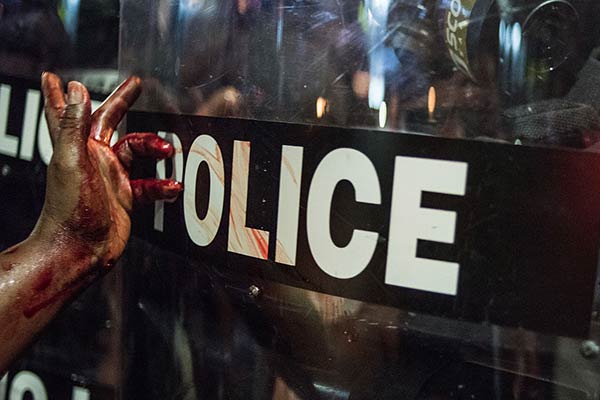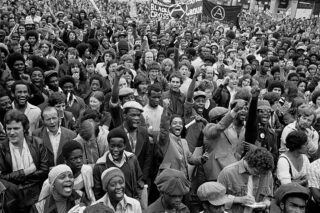Keith Lamont Scott and the Legacy of Police Violence
Coinciding with Aperture magazine’s “Vision & Justice” issue, students in Sarah Lewis’s Harvard University class “Vision & Justice: The Art of Citizenship” contributed essays on the relationship between images of social unrest and landmark Supreme Court decisions. Here, David E. White Jr. reflects on Sean Rayford and equal protection for African Americans.

Sean Rayford, Protests Break Out In Charlotte After Police Shooting, 2016
© the artist/Getty Images
Sean Rayford, a freelance photojournalist and commercial photographer based in Columbia, South Carolina, captured this photograph of a woman smearing blood on a police riot shield during a protest in downtown Charlotte, North Carolina at about 9:00pm on September 21, 2016. Citizens were protesting the death of Keith Lamont Scott, a black man, who was shot and killed by the police the previous day. Married for more than twenty years, and a father of seven children, Scott was forty-three years old and had worked as a security guard at a local mall.
Mindful that photographs must be “composed to be readable” by his audience, Rayford often relies on his subjects’ faces to capture the emotion of a moment. But in this frame, faces are conspicuously absent. Instead, the hand of a black woman, soaked in blood, is wiped across a military-grade police riot shield. Describing the scene leading up to the photograph, Rayford recalled, “It happened right in front of me. I was surprised. I thought, ‘She’s going to do this—she’s going to smear blood on the shield’ … It’s almost as if she was saying, ‘The blood’s on you.’” Rayford believes the blood on the woman’s hand belonged to twenty-six-year-old Justin Carr, a black protestor who was shot and later died while demonstrating Scott’s death at the hands of police.
This photograph of a bloody hand on the police shield underscores that black citizens have yet to attain full American citizenship in that blacks still suffer an equal protection deficit. The U.S. legal system continues to prove that, practically speaking, the snuffing out of black lives by police is legally permissible, and Screws v. United States (1945) is one of the leading cases for this proposition. In Screws, a county sheriff and other law enforcement officers detained Robert Hall, a black man, under the guise of a potentially fraudulent arrest warrant. Once in the officers’ custody, Sheriff Screws and his fellow officers beat Hall to death, allegedly over a grudge. When the State of Georgia refused to prosecute the officers, the federal government interceded and charged the men under 18 U.S.C. § 242, a federal statute making it a crime for “whoever, under color of any law … willfully subjects any person … to the deprivation of any rights, privileges, or immunities secured or protected by the Constitution or laws of the United States.”
In a plurality opinion, the Court adopted a sharply narrow reading of § 242, finding that the defendant must have acted with “a purpose to deprive a person of a specific constitutional right.” This cramped interpretation not only led to Sheriff Screws and his co-defendants’ acquittal, but also stymied federal prosecution of law enforcement under § 242 for the next several decades, including through the present day. And although some scholars have noted that the Screws decision helped speed the development of 42 U.S.C. § 1983, the civil analogue to § 242, police continue to kill black people with impunity and evade federal criminal conviction because of feeble constitutional protections. If blacks were once legally considered three-fifths of a person, perhaps today’s unchecked state-sanctioned violence proves they have yet to attain the elusive two-fifths that remain.
David E. White Jr. is a third-year law student at Harvard Law School and former Captain in the U.S. Army.























